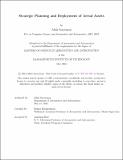| dc.contributor.advisor | Balakrishnan, Hamsa | |
| dc.contributor.author | Saravanan, Akila | |
| dc.date.accessioned | 2024-06-27T19:48:13Z | |
| dc.date.available | 2024-06-27T19:48:13Z | |
| dc.date.issued | 2024-05 | |
| dc.date.submitted | 2024-05-28T19:36:42.983Z | |
| dc.identifier.uri | https://hdl.handle.net/1721.1/155367 | |
| dc.description.abstract | The rapid deployment of fleets of small, uncrewed aircraft (drones) for tasks like package delivery or search-and-rescue in the immediate aftermath of a natural disaster are some of the most vital and common applications of advanced air mobility. Recognizing that successful drone missions depend on pre-established, well-positioned bases and efficient task allocation, this work presents a generalizable model for base positioning and routing in diverse applications. The proposed model prioritizes choosing bases that both maximize operational coverage and enable rapid responses to high-demand areas. Additionally, the framework integrates a vehicle routing component to optimize drone flight paths for efficient task completion in the tactical portion of drone-based operations; this component is the primary focus of this work. In addition to the theoretical formulation, the models are validated through case studies examining post-flooding search-and-rescue in the Iwate prefecture of Japan and package deliveries in the Austin, TX metropolitan area. | |
| dc.publisher | Massachusetts Institute of Technology | |
| dc.rights | Attribution-NonCommercial-NoDerivatives 4.0 International (CC BY-NC-ND 4.0) | |
| dc.rights | Copyright retained by author(s) | |
| dc.rights.uri | https://creativecommons.org/licenses/by-nc-nd/4.0/ | |
| dc.title | Strategic Planning and Deployment of Aerial Assets | |
| dc.type | Thesis | |
| dc.description.degree | S.M. | |
| dc.contributor.department | Massachusetts Institute of Technology. Department of Aeronautics and Astronautics | |
| mit.thesis.degree | Master | |
| thesis.degree.name | Master of Science in Aeronautics and Astronautics | |
